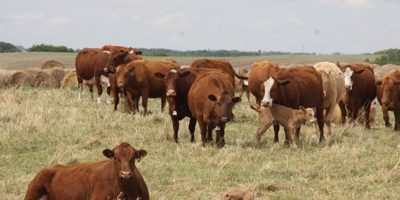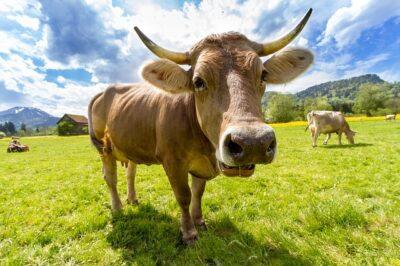It’s a sad sight to see cattle, horses and other livestock grazing in a dry, dead-looking pasture. Perhaps you are struggling with your pastures or just moved to a new property and have found that the land is fairly unproductive. Sadly, pastures are often neglected, and while this may work in giant hundred-acre lots of grazing land, this isn’t going to work in the average pasture.
If you are struggling with a yellowed, weed-filled lot, don’t panic. You can reverse your pasture with time and bring it back to health.
Why Pastures Don’t Thrive
First off, it is important to understand why pastures don’t thrive. Fixing the problem is one thing, but learning what proper management is so you can prevent this problem from repeating is vital.
Everything you need to know to keep a cow healthy, happy, and productive… [2]
There may be uncontrollable forces that can damage a pasture, like erosion from a storm or flood, insects or even a fire. The majority of the time, though, a pasture failing to thrive is due to a lack of management.
New homesteaders may be surprised to learn that pastures need to be managed and cared for similarly to how a lawn is tended to, although far less effort is involved. This is especially true if you graze livestock, plan to hay or otherwise use the acreage. If you want maximum health and production, it’s going to take some work.
Basic pasture management involves these key areas:
1. Rotational Grazing and Use of Sacrifice Pens
Again, unless you have a huge range for livestock like those in the beef cattle industry, you need to manage when and how long your livestock graze. Too many people put some cows or some horses into one pasture and then wonder why weeds and bare patches of earth start popping up everywhere.
Just like people, livestock are going to want to eat the tastiest pieces of food first. The best grass, shrubs, legumes and other plants will be eaten first, which is going to cause them to overgraze these areas. As the earth and plants get damaged from overgrazing, weeds will be able easily to take over.
If you have a small one acre or even a half-acre pasture, you should invest in some fencing, perhaps electric strands to save money, so you can break up the pasture into smaller paddocks. Livestock will only be in one paddock at a time and once they’ve sufficiently eaten, they are moved to the next. This process prevents overgrazing, allows for better natural fertilization from the animal’s manure and give each paddock plenty of time to grow and recover before being grazed again.
You should also have a sacrifice pen. A sacrifice pen is simply a fenced area where you can keep your livestock during the rainy seasons of your climate. This pen will often end up completely bare and trampled down, but it will save your pasture from damage.
2. Weeding and Removing Noxious Weeds
Weed control is another important aspect of pasture management. The worst cases of weeds are often due to overgrazing, but some regions have infestations of noxious weeds. Noxious weeds are considered to be invasive and non-native. They compete with native plant species, and some are quite toxic. Native weeds may be toxic, too, which is why it’s important to inspect your pasture for toxic plants before adding livestock.
This Book Clearly Illustrates What An Easy And Rewarding Experience Raising Goats Can Be. [3]
Weeds of all types can be pulled, burned, treated with an herbicide (natural ones are available), chopped, etc. The technique you use will depend on the plant as some won’t die from, say, cutting the plant because the roots are still present.
3. Fertilizing
 [4]Relying on your livestock to do all of your fertilizing isn’t as straightforward as you think. Many species of grazing livestock like horses or cattle often have a favorite spot to relive themselves. This means you could end up with one giant pile of manure that ruins the pasture below it. Additionally, livestock can’t very well spread out their manure, so it takes a while to break down.
[4]Relying on your livestock to do all of your fertilizing isn’t as straightforward as you think. Many species of grazing livestock like horses or cattle often have a favorite spot to relive themselves. This means you could end up with one giant pile of manure that ruins the pasture below it. Additionally, livestock can’t very well spread out their manure, so it takes a while to break down.
Some people choose to use a fertilizer for their pastureland — which is fine — but you shouldn’t forget to spread out the livestock manure (which is a great fertilizer after this step is done). The easiest way to is to use a harrow rake to break up the clumps and spread it. Or you can go the DIY route and create your own rake made from a section of chain-link fencing to pull behind your ATV, tractor, golf cart, car, etc.
4. Mowing
Mowing seems silly if you have livestock that will happily eat the grass, but this chore is another aspect of pasture management. As livestock graze, even in a rotational grazing setup, they will still eat more of some areas than others. This leaves some grass shorter and some grass longer. Mowing evens out the grass to one length, which actually improves growth.
Want The Best Chemical-Free, All-Natural Insecticide — For Your Garden AND Home? [5]
If you have an empty pasture or have many rotational pens that grass growth becomes unruly between use, mowing also will keep it to a healthy level.
5. Regular Visual Inspections
Take the time to walk through your pasture on a regular basis. You can check fencing, remove any garbage and see how the pasture is doing. Many pasture problems like weeds could have been nipped in the bud if someone had noticed them before they got out of hand. Look out for noxious weeds, dangerous holes, bare patches of earth and take notice of which areas may be doing poorly from overgrazing.
More Tips for Helping a Damaged Pasture
Here are a few more tips to try if you aren’t happy with the growth or production of your pasture:
- Resist the urge to completely tear up the existing pasture and start over. This damages the microorganisms present in the ground already, is going to cost you money to rent equipment and will set you back considerably in how long you’ll have to wait to graze livestock.
- If the pasture is lacking in healthy grasses, legumes and other plants, consider tilling the worst areas and reseeding to get more growth. Reseeding shouldn’t have to be done often if proper pasture management is followed.
- When seeding bare spots in the pasture, you’ll first need to till up the ground as it’s probably been compressed. After seeding the appropriate type, spread a light layer of straw over it to protect the new growth. Figure out a way to water this area and be sure you fence it off to prevent further damage while the new grass grows in.
- Consult your local agricultural authority or extension office to get information on which weeds are noxious to your area and how to get rid of them. Sometime they may even have someone come remove them for you to ensure it’s done properly.
- For a truly ruined pasture or one that you have to completely reseed, keep all livestock off of it until the grasses are mature. Typically, a good rule of thumb is to wait until you’ve had to mow the grass back to four inches at least twice.
- Very damaged pastures or ones that you can’t seem to revive need a soil test done. Doing a soil test annually as a preventive measure isn’t a bad idea. This test will tell you if there are deficiencies within the ground that are causing the problems. An added benefit is that you will also learn which minerals your livestock could be lacking from eating plants grown in the soil.
Getting a damaged pasture back to health isn’t as difficult as many people think. With some work and patience, your pasture can be looking good again.
How does your pasture look? Do you have any tips for people struggling with maintaining a healthy pasture? Please share any helpful advice with others in the comment section below!
Harness The Power Of Nature’s Most Remarkable Healer: Vinegar [6]

